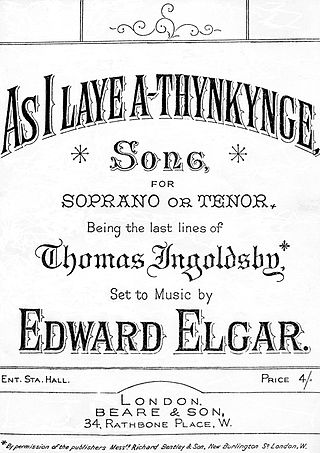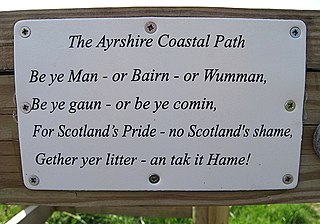Related Research Articles
The Corpus Christi Carol or Falcon Carol is a Middle or Early Modern English hymn, first written down by an apprentice grocer named Richard Hill between 1504 and 1536. The original writer of the carol remains anonymous. The earliest surviving record of the piece preserves only the lyrics and is untitled. It has survived in altered form in the folk tradition as the Christmas carol "Down In Yon Forest". The structure of the carol is six stanzas, each with rhyming couplets. The tense changes in the fourth stanza from past to present continuous.

Gervase Henry Cary-Elwes, DL, better known as Gervase Elwes, was an English tenor of great distinction, who exercised a powerful influence over the development of English music from the early 1900s up until his death in 1921 due to a railroad accident in Boston at the height of his career.
"Songs My Mother Taught Me" is a song for voice and piano written in 1880 by Antonín Dvořák. It is the fourth of seven songs from his cycle Gypsy Songs, B. 104, Op. 55. The Gypsy Songs are set to poems by Adolf Heyduk in both Czech and German. This song in particular has achieved widespread fame.

Maude Valérie White was a French-born English composer who became one of the most successful songwriters of the Victorian period.

John Coates was a leading English tenor, who sang in opera and oratorio and on the concert platform. His repertoire ranged from Bach and Purcell to contemporary works, and embraced the major heldentenor roles in Richard Wagner's operas. For more than 40 years, with only a four-year interruption for military service during World War I, he overcame the limitations of a voice that was not naturally large by impressing listeners with his intense artistic expression, lively diction, musical versatility and memorable stage presence.

Marie Brema was a British dramatic mezzo-soprano active in concert, operatic and oratorio roles during the last decade of the 19th and the first decade of the 20th centuries. She was the first British singer to appear at the Bayreuth Festspielhaus.
"Coulter's Candy", also known as "Ally Bally" or "Ally Bally Bee, is a Scots folk song.
"Pleading" is a poem written by Arthur L. Salmon, and set to music by the English composer Edward Elgar in 1908, as his Op.48.
"The Lochmaben Harper" or "The Blind Harper" is a traditional British Folk ballad and is one of the ballads collected by Francis Child in The English and Scottish Popular Ballads (1882–1898).
Oh, soft was the song is a song with words by Gilbert Parker set to music by the English composer Edward Elgar in 1910, as his Op. 59, No. 3. It is the second and last verse of a poem At Sea which Parker published in Volume I of a series of poems called Embers. The Opus 59 songs were part of a song-cycle of six romantic songs by Parker that was never completed – Nos 1, 2 and 4 were never composed. The other songs were Was it some Golden Star? and Twilight. The songs were originally written with piano accompaniment, but this was later re-scored by the composer for full orchestra.
"A Song of Autumn" is a poem by Adam Lindsay Gordon set to music by Edward Elgar in 1892.

"As I laye a-thynkynge" is the last poem written by "Thomas Ingoldsby". It was set to music by the English composer Edward Elgar.

In the Dawn is a song written by the English composer Edward Elgar in 1901 as his Op.41, No.1.

Speak, Music! is a song written by the English composer Edward Elgar in 1901 as his Op.41, No.2.

”Always and Everywhere” is a song by the English composer Edward Elgar with words translated from the Polish of Zygmunt Krasiński by Frank H. Fortey. It was composed and published in 1901.
”XTC” ("Ecstasy") is a song with words and music written by the English composer Edward Elgar in 1930. It was his last song, and written for the soprano Joan Elwes.

Modern Scots comprises the varieties of Scots traditionally spoken in Lowland Scotland and parts of Ulster, from 1700.

Gideon Gee-Bum Kim is a Korean-Canadian classical music composer, conductor, and music educator and founder of the Toronto Messiaen Ensemble. His music draws on his Christian faith and shows a connection of the rich musical heritage of Korea and new compositional techniques, especially in the field of heterophony texture and all of this with live and emotional imagination.
Joan Izott Elwes (1895-1961) was an English soprano and music teacher.

The recorded source of the children's story The Marriage of Robin Redbreast and the Wren is Isabella Burns, later Mrs Isabella Burns Begg, the youngest sister of Robert Burns. Isabella recalled that her brother, Robert Burns, was the author and that he was in the habit of telling the tale to entertain the younger members of his family at Lochlea Farm, such as herself, Annabella, John and William. This nursery tale was first published by Dr Robert Chambers in his "Popular Rhymes of Scotland".
References
- ↑ Kennedy, Michael (1968). Portrait of Elgar. Oxford University Press. ISBN 0-19-315414-5.
- ↑ York Symphony Orchestra People. "Photograph of Joan Elwes".[ dead link ]
- ↑ Martin Bird, The Elgar Society Journal, Vol.19 No.6 - December 2016
- ↑ "'The Lea-Rig' by Robert Burns". Archived from the original on 26 August 2011. Retrieved 21 July 2008.